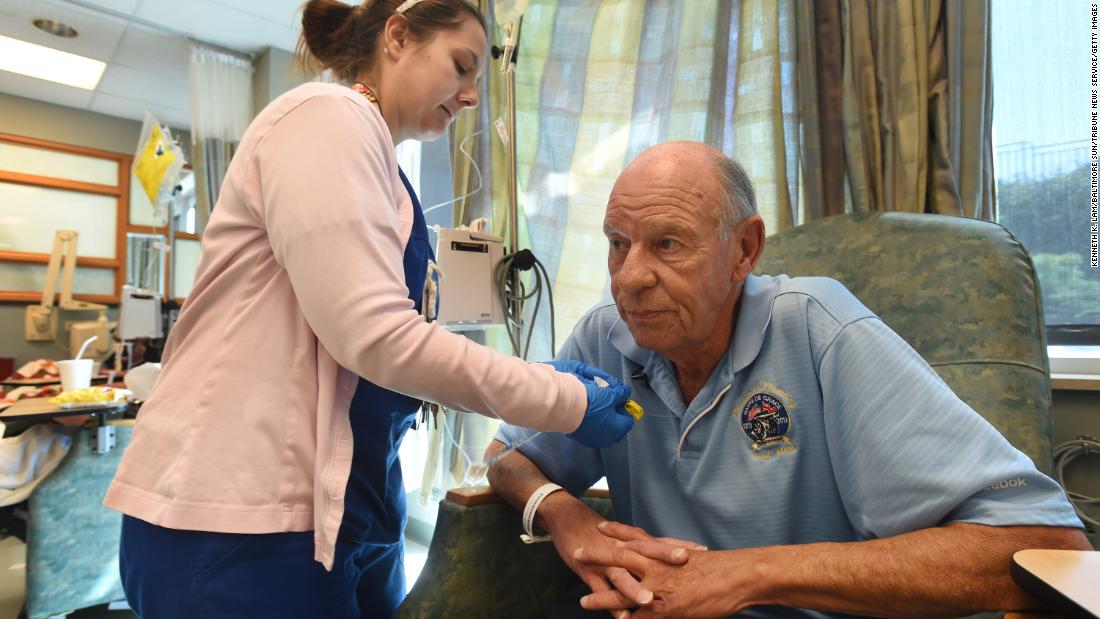Adamari López highlights the importance of checking your breasts 1:59
(CNN) -
Cancer death rates have been declining for nearly two decades, in part due to "great strides" in lung cancer early detection and treatment options, according to the annual report of the American Cancer Society. Cancer on Oncology Statistics, published this Wednesday.
The global cancer death rate fell by about a third (32%) from its peak in 1991 to 2019, from about 215 deaths per 100,000 people to about 146, preventing about 3.5 million deaths during that time, according to the data.
Most of this decline can be attributed to decreased mortality among lung cancer patients.
Alert about drastic reduction of CT scans to detect cancer 0:41
The American Cancer Society projects that in 2022 there will be about 1.9 million new cancer diagnoses and more than 609,000 cancer deaths in the United States, including about 350 daily deaths from lung cancer, the leading cause of cancer death.
In 2019, about one in four cancer deaths were in lung cancer patients, but lung cancer deaths are declining faster than overall trends.
Lung cancer death rates fell by approximately 5% each year between 2015 and 2019, while overall cancer mortality fell by approximately 2% in that time.
And continuing downward trends are cause for optimism, experts say.
"I'm an oncologist, so I'm a die-hard optimist. But I think the key message to the public is that there is room for optimism in all types of cancer," said Dr. Deb Schrag, head of the medical department at Memorial Sloan Kettering. Cancer Center.
advertising
Further progress in reducing the curve will require a three-pronged approach, with strong and unified efforts in prevention, testing and treatment, he said.
The HPV vaccine reduced cervical cancer rates by 87% in some women, according to a UK study
According to the American Cancer Society report, programs aimed at preventing smoking or quitting smoking can have a big impact, as can yearly screening tests.
"The data tells us, from a wellness perspective, that quitting smoking at any age, at any time and with any level of habit is beneficial to health," Karen Knudsen, CEO of the American Cancer Society, told CNN.
"Studies have shown that for someone who is diagnosed with cancer, regardless of the type of cancer, lung or other, quitting smoking at the time of cancer diagnosis is strongly associated with a better outcome. So Therefore, quitting smoking is important not only to prevent cancer, but also to have the best possible chance of obtaining a good result if you are undergoing treatment. "
And while lung cancer testing has only increased slightly of late, from 2% of eligible people in 2010 to 5% in 2018, the effects have been much greater.
About 28% of lung cancer diagnoses in 2018 were detected early in the "localized stage", up from 17% in 2004. And more than 30% of patients lived at least three years after their diagnosis, compared to twenty-one%.
Increasing screening for all types of cancer is critical, Knudsen told CNN.
"Even before the covid, the acceptance of the tests was not necessary among the American public," he said, and the tests for lung cancer are among the least accepted.
In his previous position at a cancer center designated by the National Cancer Institute, Knudsen noted that testing decreased each time COVID-19 cases reached their peak.
But these screening delays could lead to tens of thousands of preventable deaths in the coming years, and it is "urgent" for individuals to put in place a screening plan.
"For all individuals, what I would hope is that they feel empowered to have that conversation with their GP, I cannot stress this enough, to ask 'what is the right screening plan for me based on my personal history? and my family history and, if I know, my genetic history? '"
Experts lower the recommended age to start colorectal cancer screening to 45 years
While lung cancer is the most common overall and the one that causes the most deaths among men and women, prostate cancer is the most common among men and breast cancer is the most common among women, according to the report.
Late-stage diagnoses are increasing for both prostate and breast cancers, which can be detected early.
And cervical cancer continues to cause thousands of deaths, despite being almost completely preventable.
Advances in treatment are capable of producing a more immediate change than changes in health behaviors.
In general terms, precision medicine, which refers to understanding the molecular factors or genetic characteristics of cancers to treat them more strategically, and immunotherapies developed thanks to a better understanding of the
immune system have changed the rules of the game " Schrag stated.
The improvements in life expectancy after lung cancer diagnosis occurred primarily among patients with non-small cell lung cancer and, in terms of treatment, were driven by advances in diagnostic and surgical procedures, such as video-assisted thoracoscopic surgery, as well as medical therapies such as immunotherapy that were approved by the US Food and Drug Administration (FDA) in 2015.
But trends in cancer deaths are largely driven by changes in lifestyle and care over the decades, experts say.
"For example, when we look at current advances and the continued decline in lung cancer deaths, part of it is because smoking rates started to decline 20 to 30 years ago," says Schrag.
"Today we are reaping some of those benefits."
The importance of early detection of breast cancer: knowing to live
Not all long-term effects are positive.
According to the American Cancer Society report, racial and sociodemographic disparities in cancer incidence and mortality also persist due to the long-lasting effects of systemic racism in the United States.
Black patients have a lower five-year survival rate than white patients for most types of cancer, and black women have a higher cancer death rate than any other group, according to data from the American Cancer Society.
Although the incidence rate of breast cancer is 4% lower in black women than in white women, mortality from breast cancer is 41% higher in black women.
Cancer








